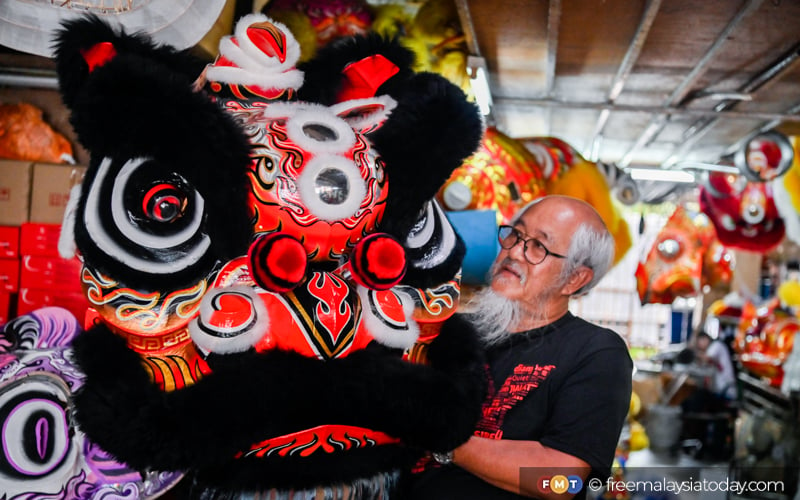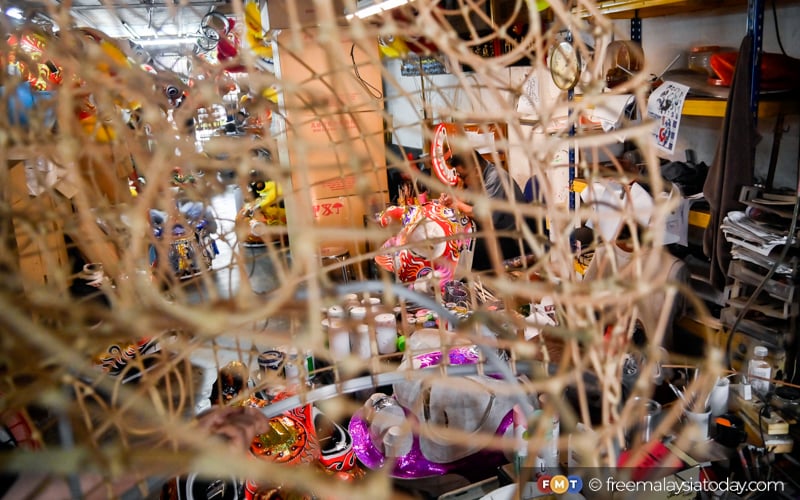
PETALING JAYA: For six days a week, Siow Ho Phiew, fondly known as Master Siow, sits in his cramped workshop in Shah Alam, bending strip after strip of rattan to form the base of lion heads.
Sitting amid cans of acrylic paint and huge boxes of finished orders, he reminisces about the beginning of his Wan Seng Hang business.
Siow established Wan Seng Hang in 1986 after years of teaching himself the niche skills of putting together a traditional lion head.
“I didn’t have a master to learn this craft from. I mastered the art through trial and error, and I’ve never stopped improving and finding ways to elevate my craft,” he told FMT.

Siow’s love for the art can be traced back to his passion for wushu, which led him to join a lion dance team in Subang when he was 19, as the two sports are closely related.
“When I was in the lion dance team, I realised it was not easy for us to get a lion head, so I decided to make a few myself. Later on, people told me they admired my work, so I started focusing more on the craft.”
Now with a dozen workers by his side, Siow’s business can produce up to 300 lion dance costumes a year, which include an intricately designed lion head, body and two pairs of pants.
Siow’s work has won widespread praise, with fans travelling from all over the world to learn from the master.
“The lion heads I made have gained the recognition of many people around the world. I’m happy to know that they are supporting my craft,” he said.
“If I have free time and my schedule allows, I also travel to other countries to teach lion dancing. I’ve been to New Zealand, Australia, the US, and Canada.”
Siow also expressed gratitude to his loyal customers who ordered lion heads from him during the Covid-19 pandemic to keep his business afloat, despite the movement control order’s ban on outdoor activities.
The origins of lion dance costumes
Malaysia’s lion dance costume designs have come to adopt the appearance of Fo Shan and He Shan lions, originating from the Guangdong province in China.
Siow said the lions used to be based on characters from the “Romance of the Three Kingdoms”, a historical novel set in Imperial China towards the end of the Han dynasty.
“A colourful lion is usually inspired by the character Liu Bei, a red lion is Guan Gong, a black lion represents Zhang Fei while a Zhao Yun lion is green,” he said.
However, he said people had now forgotten about those distinctions and opt for whichever colour combination they believe will attract good luck and fortune.
Taking an average of eight days to make, a lion head takes its durability from the first step of the process, which includes building a frame made out of rattan that will provide the structure with a strong foundation.
“Usually, a lion head is made out of bamboo, but Malaysia has a lot of rattan. We have the best rattan in the world. It is very durable and firm,” Siow said.
The spirit of ‘bersatu’
The 69-year-old artisan, who is also a lion dance performer, said he was proud of how far Malaysia had come in developing the art.
“The high pole lion dance performance was founded in Malaysia. The lion dance competitions we have here are more creative than in any other country. That is why Malaysia has been labelled as ‘the kingdom of lion dance’,” he said.
For Siow, the lion dance signifies unity, or “bersatu”, as the performance is dependent on the collaboration of a group of people.
“One person will never be able to make the lion dance work. Two people can control the head and body of the lion, but no one will be there to play the drums and gong.
“We used to say that the lion dance is part of Chinese culture, but Malaysia has three major ethnicities, and the art has captured their hearts, too. That’s why we like to say it belongs to everyone now,” he said.



No comments:
Post a Comment
Note: Only a member of this blog may post a comment.